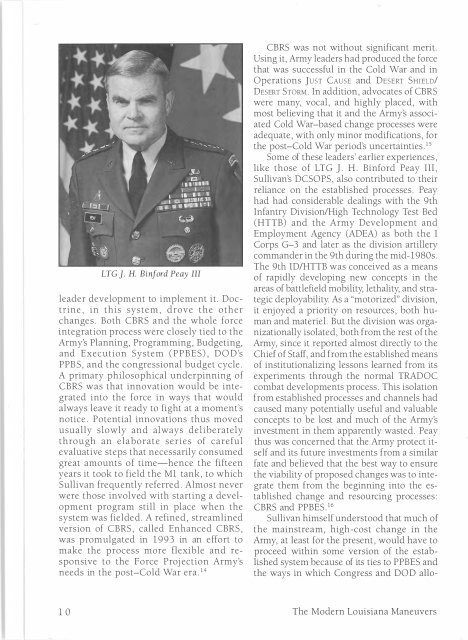The Modern Louisiana Maneuvers - US Army Center Of Military History
The Modern Louisiana Maneuvers - US Army Center Of Military History
The Modern Louisiana Maneuvers - US Army Center Of Military History
You also want an ePaper? Increase the reach of your titles
YUMPU automatically turns print PDFs into web optimized ePapers that Google loves.
LTG ]. H. Binford Peay III<br />
leader development to implement it. Doctrine,<br />
in this system, drove the other<br />
changes. Both CBRS and the whole force<br />
integration process were closely tied to the<br />
<strong>Army</strong>'s Planning, Programming, Budgeting,<br />
and Execution System (PPBES), DOD's<br />
PPBS, and the congressional budget cycle.<br />
A primary philosophical underpinning of<br />
CBRS was that innovation would be integrated<br />
into the force in ways that would<br />
always leave it ready to fight at a moment's<br />
notice. Potential innovations thus moved<br />
usually slowly and always deliberately<br />
through an elaborate series of careful<br />
evaluative steps that necessarily consumed<br />
great amounts of time-hence the fifteen<br />
years it took to field the M1 tank, to which<br />
Sullivan frequently referred. Almost never<br />
were those involved with starting a development<br />
program still in place when the<br />
system was fielded. A refined, streamlined<br />
version of CBRS , called Enhanced CBRS,<br />
was promulgated in 1993 in an effort to<br />
make the process more flexible and responsive<br />
to the Force Proj ection <strong>Army</strong>'s<br />
needs in the post-Cold War era. 14<br />
10<br />
CBRS was not without Significant merit.<br />
Using it, <strong>Army</strong> leaders had produced the force<br />
that was successful in the Cold War and in<br />
Operations J<strong>US</strong>T CA<strong>US</strong>E and DESERT SHIELD/<br />
DESERT STORM. In addition, advocates of CBRS<br />
were many, vocal, and highly placed, with<br />
most believing that it and the <strong>Army</strong>'s associated<br />
Cold War-based change processes were<br />
adequate, with only minor modifications, for<br />
the post-Cold War period's uncertainties. 15<br />
Some of these leaders' earlier experiences,<br />
like those of LTG ]. H. Binford Peay III,<br />
Sullivan's DCSOPS, also contributed to their<br />
reliance on the established processes. Peay<br />
had had considerable dealings with the 9th<br />
Infantry Division/High Technology Test Bed<br />
(HTTB) and the <strong>Army</strong> Development and<br />
Employment Agency (ADEA) as both the I<br />
Corps G-3 and later as the division artillery<br />
commander in the 9th during the mid-1980s.<br />
<strong>The</strong> 9th ID/HTTB was conceived as a means<br />
of rapidly developing new concepts in the<br />
areas of battlefield mobility, lethality, and strategic<br />
deployability. As a "motorized" division,<br />
it enjoyed a priority on resources, both human<br />
and materiel. But the division was organizationally<br />
isolated, both from the rest of the<br />
<strong>Army</strong>, since it reported almost directly to the<br />
Chief of Staff, and from the established means<br />
of institutionalizing lessons learned from its<br />
experiments through the normal TRADOC<br />
combat developments process. This isolation<br />
from established processes and channels had<br />
caused many potentially useful and valuable<br />
concepts to be lost and much of the <strong>Army</strong>'s<br />
investment in them apparently wasted. Peay<br />
thus was concerned that the <strong>Army</strong> protect itself<br />
and its future investments from a similar<br />
fate and believed that the best way to ensure<br />
the viability of proposed changes was to integrate<br />
them from the beginning into the established<br />
change and resourcing processes:<br />
CBRS and PPBES.16<br />
Sullivan himself understood that much of<br />
the mainstream, high-cost change in the<br />
<strong>Army</strong>, at least for the present, would have to<br />
proceed within some version of the established<br />
system because of its ties to PPBES and<br />
the ways in which Congress and DOD allo-<br />
<strong>The</strong> <strong>Modern</strong> <strong>Louisiana</strong> <strong>Maneuvers</strong>
















